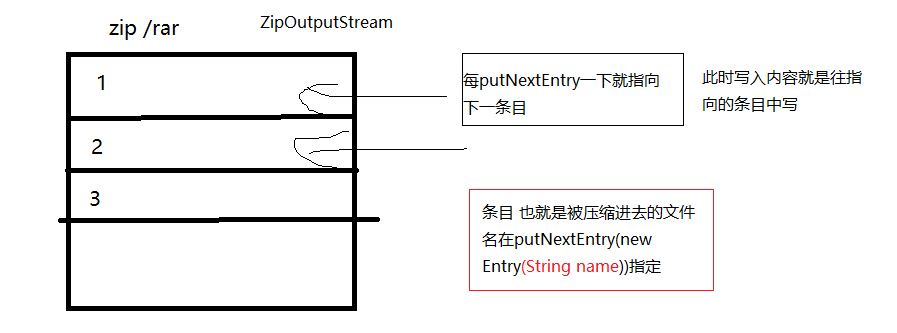1.对象流
import java.io.ByteArrayInputStream;
import java.io.ByteArrayOutputStream;
import java.io.File; import java.io.FileInputStream; import java.io.FileOutputStream; import java.io.IOException; import java.io.InputStream; import java.io.ObjectInputStream; import java.io.ObjectOutputStream; import java.io.Serializable; public class ObjectStreamDemo implements Serializable { public static void main(String[] args) { test3(); } class Person implements Serializable { String name = ""; int score = 0; public String getName() { return name; } public void setName(String name) { this.name = name; } public int getScore() { return score; } public void setScore(int score) { this.score = score; } @Override public String toString() { return "Person [name=" + name + ", score=" + score + "]"; } } /** * 向 一个文本文件中写入一个对象 */ private static void test1() { File file = new File("./PerObjectStoreTxt.txt"); FileOutputStream fos = null; // 创建 ObjectOutputStream 构造器中传入一个OutputStream对象 ObjectOutputStream oos = null; try { fos = new FileOutputStream(file); // 创建 ObjectOutputStream 构造器中传入一个OutputStream对象 oos = new ObjectOutputStream(fos); oos.writeObject(new ObjectStreamDemo().new Person()); Person p2 = new ObjectStreamDemo().new Person(); p2.setName("张三"); p2.setScore(100); oos.writeObject(p2); } catch (IOException e) { // TODO Auto-generated catch block e.printStackTrace(); } finally { if (oos != null) try { oos.close(); } catch (IOException e) { // TODO Auto-generated catch block e.printStackTrace(); } } } /** * 从一个文本文件 读取多个对象 * * @throws */ private static void test2() { File file = new File("./PerObjectStoreTxt.txt"); Person p1; Person p2; InputStream fis = null; ObjectInputStream ois = null; try { fis = new FileInputStream(file); ois = new ObjectInputStream(fis); p1 = (Person) ois.readObject(); p2 = (Person) ois.readObject(); System.out.println(p1); System.out.println(p2); } catch (ClassNotFoundException e) { e.printStackTrace(); } catch (IOException e) { e.printStackTrace(); } finally { if (ois != null) try { ois.close(); } catch (IOException e) { e.printStackTrace(); } } } /** * 完成 对象的深克隆 */ private static void test3() { Person p1=new ObjectStreamDemo().new Person(); String pName =new String("张三");//最终看这个东西的指向是否还一样 p1.setName(pName); /** *由此可以看出 ByteArrayIOStream 还是有点用的 主要就是继承IOStream这点 * 有了这点 这个东西 就分别可以作为 ObjectIIOStream的构造器参数传入 * 因为 ObjectInputStream(InputStream is) ObjectOutputStream(OutputStream) * 他俩就提供 这么 两个东西 */ ByteArrayOutputStream baos =null; ByteArrayInputStream bais=null; ObjectOutputStream oos=null; ObjectInputStream ois=null; try { baos=new ByteArrayOutputStream(); oos=new ObjectOutputStream(baos); oos.writeObject(p1); /** *如何完成 ByteArrayOutputStream 和ByteArrayInputStream 东西的交互? * * 实际上这两个东西 只是继承的东西不一样 底层其他基本一样: * 实际上 这两个东西 都要 自己手动支取: * ByteArrayOutputStream() 写进去数组还能 用toString toByteArray拿出来 * ByteArrayInputStream(byte[] b) 还需要传byte[]进去 ,可见这个东西古老 */ bais=new ByteArrayInputStream(baos.toByteArray()); ois=new ObjectInputStream(bais); //获取深克隆 Person p2=(Person)ois.readObject(); System.out.println(p2); //修改 克隆对象里边的 成员对象 p2.name="lisi"; //看原对象的 成员对象是否更改 System.out.println(p1); //再看 这个被克隆的对象 是否被更改 System.out.println(p2); } catch (IOException e) { // TODO Auto-generated catch block e.printStackTrace(); } catch (ClassNotFoundException e) { // TODO Auto-generated catch block e.printStackTrace(); }finally{ try { oos.close(); } catch (IOException e) { // TODO Auto-generated catch block e.printStackTrace(); } try { ois.close(); } catch (IOException e) { // TODO Auto-generated catch block e.printStackTrace(); } } } }
2.内存流 /数组流 :
其实就是一个纯数组操作!
这个东西 和AbstractStringBuilder 区别不大 ,就这么3个区别:
- ByteArrayOutputStream 存的是byte[]
- 具有 write到其他OutputStream 的方法
- 还有就是没有CAPACITY
public class ByteArrayOutputStream extends OutputStream{
protected byte buf[]; protected int count; //ByteArray写入流有两个 构造器 传入默认的数组容量参数 //而ByteAarry写出流 因为一旦放进去 就不允许更改,所以只有一个传byte[] public ByteArrayOutputStream() { this(32); } public ByteArrayOutputStream(int size) { if (size < 0) { throw new IllegalArgumentException("Negative initial size: " + size); } buf = new byte[size]; } public synchronized void write(int b) { int newcount = count + 1; if (newcount > buf.length) { buf = Arrays.copyOf(buf, Math.max(buf.length << 1, newcount)); } buf[count] = (byte)b; count = newcount; } public synchronized void write(byte b[], int off, int len) { if ((off < 0) || (off > b.length) || (len < 0) || ((off + len) > b.length) || ((off + len) < 0)) { throw new IndexOutOfBoundsException(); } else if (len == 0) { return; } int newcount = count + len; if (newcount > buf.length) { buf = Arrays.copyOf(buf, Math.max(buf.length << 1, newcount)); } System.arraycopy(b, off, buf, count, len); count = newcount; } public synchronized void writeTo(OutputStream out) throws IOException { //重新 写入新的 输出流 这个类这么一搞算是废了 out.write(buf, 0, count); } public synchronized void reset() { count = 0; } public synchronized byte toByteArray()[] { //这写法6 return Arrays.copyOf(buf, count); } public synchronized int size() { return count; } public synchronized String toString() { return new String(buf, 0, count); } public synchronized String toString(String charsetName) throws UnsupportedEncodingException { return new String(buf, 0, count, charsetName); } public synchronized String toString(int hibyte) { return new String(buf, hibyte, 0, count); } //这个 两个流是直接 写入内存的 内存管理 会进行回收处理 //所以不需要手动关流 这个 close()方法也就是空的 public void close() throws IOException { } }
所以说这个东西最大的作用就是ByteArrayOutputStream 和ByteArrayInputStream 分别是OutputStream 和InputStream 的子类 如果要用到对象流传进去会方便一些。
如果说要把 ByteArrayOutputStream的东西拿出来 两招 直接
toString() 或者说
getBytes()
3.压缩流
压缩流 是用来 把一个文件 写进一个压缩包里。
这个流 不在 io包下 它是在 java.util.zip
如果我们要传输一个较大的文件 那么就要使用压缩技术
简单传达一下 这里边的东西 :就这么三个东西
ZipInputStream 解压工具
ZipOutputStream 压缩工具
ZipEntry代表的是压缩包中的一个文件实体。
如何压缩文件
直接用ZipIO流去包装IO流
比如说直接用ZipOutputStream 去包装 FileOutputStream 对象
package ZipOutputStreamDemo;
import java.io.File;
import java.io.FileInputStream; import java.io.FileOutputStream; import java.io.IOException; import java.util.zip.ZipEntry; import java.util.zip.ZipOutputStream; public class ZipOutputStreamDemo { public static void main(String[] args) { test1(); } /** * 创建 .zip文件 把这个文件封装到ZipFile对象里 直接用ZipOutPutStream 把要写的文件写进去就OK了 */ // 把文件 1.txt demo.class 实例.PNG 写入 压缩包 one.zip private static void test1() { File zipFile = new File("C:/Users/zongjihengfei/Desktop/one.rar/"); // 无论存在与否 先把它创建出来 try { zipFile.createNewFile(); } catch (IOException e1) { e1.printStackTrace(); } FileOutputStream fos = null; ZipOutputStream zos = null; // 拿到 一个文件 File file = new File("./1.txt"); // 用 文件输入流 去获取把 文件内容 读取进来 FileInputStream fis = null; try { fos = new FileOutputStream(zipFile); // ZipOutputStream(OutputStream os) zos = new ZipOutputStream(fos); fis = new FileInputStream(file); int hasRead = 0; /** * ZipOutputStream 对象 是由文件条目构成的 也就是说 你每添加一个条目 再往里边写 写的内容就是给这个条目 * * 条目 文件名 在 new ZipEntry(String Name)写上 条目内容 每添加一个条目就写哪个文件 */ zos.putNextEntry(new ZipEntry(file.getName())); //首先要增加条目才能往这个条目里边写 byte[] b = new byte[1024]; //最大吞吐量 while ((hasRead = fis.read(b)) != -1) { zos.write(b, 0, hasRead); } } catch (IOException e) { e.printStackTrace(); } finally { try { zos.close(); } catch (IOException e) { // TODO Auto-generated catch block e.printStackTrace(); } try { fis.close(); } catch (IOException e) { // TODO Auto-generated catch block e.printStackTrace(); } } } }























 1759
1759

 被折叠的 条评论
为什么被折叠?
被折叠的 条评论
为什么被折叠?








